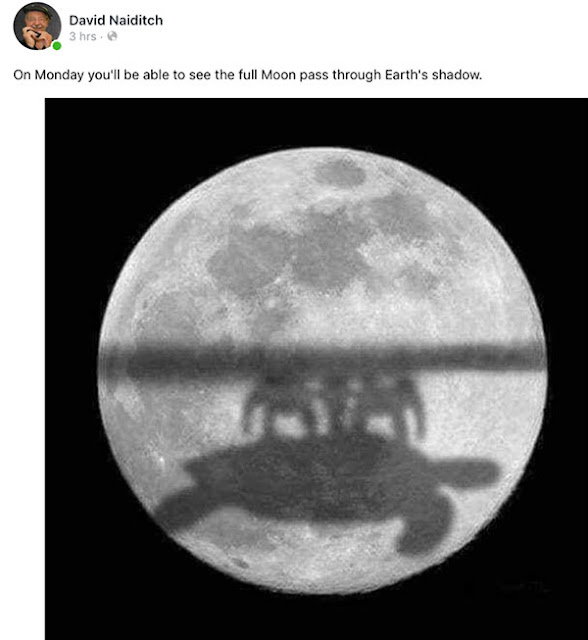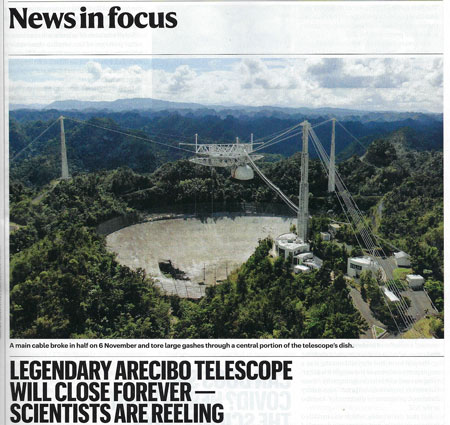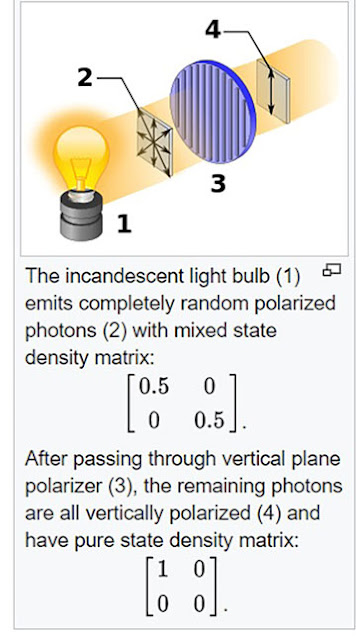Greetings from Palmia Observatory
Well, did everyone get out and look at the lunar eclipse on November 30? We first revisit one movie family that did not do well with social isolation, but can offer one "artist's" impression of what the eclipse might show and reserve the rest of the post for a discussion of quantum mechanics, density matrices and decoherence and the like.
So, first of all, as each of us continues to dwell in some form of social distancing and try to maintain our sanity and safety, we should always try to remember one family that did not do so well with being isolated. We recently saw this movie, "The Shining", on TV and it was amazing to realize that it first came out in 1980. Anyway, we should always look how our family is doing during this pandemic shutdown. Hope you are doing better than this other famous family! Yeah, just keep telling yourself we'll all be fine!
 |
| Hope that we don't end up as this socially isolated family (Source: The Shining) |
Anyway, we hope everyone is adapting better than this family and more seriously, that you are staying safe and sane. Next, let's look at the possibility of viewing the recent lunar eclipse. We did not take advantage of staying up way late at night to see the eclipse, but then we did not have to because our "friend" David N posted his imagined image of what we might find.
 |
| Can a lunar eclipse illuminate the mystery of our planet Earth? (Source: D. Naiditch on Facebook) |
Anybody get that image in your cameras? Yep, I guess the ancients might have been right, if they had observed this and in which case it is "just elephants and then turtles all the way down!"
In other astronomical news, we find this news report in the November 26 issue of Nature, that Arecibo Observatory will close forever. Sad! What is happening is it that there is no money for repair and the damage is too severe when the second main cable broke? The article describes all the details of how one main supporting cable failed and then a second cable and the existing and pending damage and danger are just too much
We were supposed to be on a tour of Arecibo in January, but that cruise was cancelled due to COVID and now we see that the whole future is not good.
 |
| Oh, no, Is Arecibo really closing forever? (Source: A. Witze, Nature, 26 Nov 2020) |
Ok, enough of the sad news about Arecibo our main topic for this post, involves what can actually be observed about strange quantum behavior. This post is based on some study of decoherence and the transition from quantum phenomena to the classical world that each of us experiences.
First up in this topic, we need to remind ourselves of the behavior of a beam of particles that enter a Stern-Gerlach device, which will test each of the individual particles and measure if the particle has "spin up" or "spin down". The next several figures are abstracted from John Townsend's "A Modern Approach to Quantum Mechanics."
A central theorem of quantum mechanics is the linearity of the Schrodinger Equation and that a solution can be the superposition of two separate solutions. This means a superposition of two possible bases, say spin up and spin down, is a possible solution. Note that a beam of particles, each as a superposition of spin up and spin down, is not the same thing as a mixture of particles, 1/2 of which are spin up and the other half spin down. How do we know this? Consider the beam of particles entering a Stern-Gerlach device which tests for spin up in the z-axis and shown in panel (a) in the figure below. If the particle beam has already been measured and is found in spin up, then a second test with a second Stern-Gerlach device will show that each of the particles is still pin up with 100% probability.
Panel (b) changes the experimental setup, slightly and now tests for spin in the x-axis, knowing that the incoming particles are definitely in spin up, z-axis. In this case 1/2 of the particles will be measured in positive x-axis spin and 1/2 with negative x-axis spin.
Panel (c) changes again the experimental setup, slightly, so that incoming particles known, now to be in positive x-axis spin and now tested for spin up in z-axis. This time we find that 1/2 of the particles will be spin up and the other half spin down.
 |
| Three experiments (Source: J. Townsend, "A Modern Approach to Quantum Mechanics") |
So, what do we know based on these experiments. We know that once a particle is measured to be in spin up, if it is again measured for spin up, yes, it will be spin up 100% of the time. If however, we take those spin up particles and test for spin in the x-axis, we find that 50% will be positive spin and 50% negative spin.
Now this is exactly what QM predicts. But what has not be conclusively shown here though is that the incoming beam of particles is in the state of a superposition and not just a mixture of particles, some up and the others down.
To start to resolve this mixture issue, and to show that the particles were really in a superposition, we have to conduct more experiments. The first part of new experiments is to use a modified Stern-Gerlach device as shown below. The Stern-Gerlach device uses a non-homogeneous magnetic field to act on the magnetic spin of incoming particles. This device separates spin up from spin down, but then recombines them into a superposition.
 |
| Three experiments (Source: J. Townsend, "A Modern Approach to Quantum Mechanics") |
Now, the next experimental setup has an incoming beam of particles known to be in z-axis, spin up orientation is applied to the modified Stern-Gerlach with orientation in the x-axis, not the z-axis. We know the modified device will change the beam into a superposition of plus and minus x-axis spins and then recombine them. Since the incoming particles where known to be spin up, when the setup tests now for spin up coming out of the modified device, yes, 100% will be spin up.
 |
| Three experiments (Source: J. Townsend, "A Modern Approach to Quantum Mechanics") |
So, now what we have learned is that it is almost certain that the original beam of particles could be considered as a superposition not as a mixture. To be really sure we need to consider density matrices and how they differ for superpositions and mixtures. Remember that the definition of a density matrix is as shown in this Wikipedia entry.
 |
| Density Matrix Definition (Source: Wikipedia, "Density Matrix") |
So, now using some slides from a YouTube video on Quantum Computing, we can see examples of density matrices for the case of a pure state superposition and how it differs for the case where a mixture is concerned. Equation (1) from the slide below shows the density matrix for the initial case for a superposition of spin up and spin down. Equation (2) shows the density matrix for a mixture. Note that the difference between the two cases is mostly the presence of off-diagonal terms for the superposition and no off-diagonal terms for the mixture.
 |
| Concept of Density Matrix (Source: YouTube, "Quantum Computing) |
With examples of the density matrix for both a pure state or superposition and a density matrix for a mixture, we can ask how the physical system, described by a pure state density matrix, transitions to a mixed state with reduced density matrix? This is where the concept of decoherence comes in. Decoherence is the process by which a pure state loses it superposition of states and becomes a mixture. Decoherence occurs when the environment interacts with the pure state quantum system and destroys the superposition.
This diagram from M. Schlosshauer's book, "Decoherence and the Quantum to Classical Transition" shows how the density matrix of a quantum system changes as it interacts and becomes entangled with atoms or other features of the environment. Other examples include measurements of of quantum spin for example, but the vacuum chamber is not operated at high enough vacuum and the remaining air molecules cause the system to decohere and become a mixture rather than remain as a superposition.
In this diagram, the quantum states are represented by Gaussian functions and you can see the representative values for all four elements in a 2 x 2 density matrix. Then as the environment becomes entangled with the quantum system, the off-diagonal terms become less and less until the system just becomes a mixture without any superposition. It is important to note that decoherence is not an all or nothing type effect and the degree of coherence is a variable.
 |
| Evolution of Density Matrix (Source: M. Schlosshauer, "Decoherence and the Quantum to Classical Transition") |
Another example of density matrices and decoherence can be seen in simple examples of optical polarizers. In the figure below, you can see a light bulb as a source of randomly polarized photons. I assume their is some decoherence between the time of emission and arrival at the polarizer, but nonetheless, the polarizer just lets vertically polarized photons through. The density matrix has no off-diagonal terms, and so is mostly a mixture, but those photons that pass through the polarizer are only oriented vertically.
Additional tests of beams of particles, such as tests are arbitrary angles, as called for in Bell tests, further illustrate the nature of beams as being in superpositions or mixed states.
 |
| The density matrix of a mixture for a beam from a polarizer (Source: Wikipedia) |
Whew, alright, that is enough of density matrices and decoherence for now. After all of this we need to have a little bit of fun, so check out this "Wanted" poster for that crazy cat animal that was used to start many a discussion of the whole topic of superposition. Check out this great Wanted Poster and see if you don't want your own tee shirt wanted poster.
 |
| Wanted: Dead or Alive - Schrodinger's Cat (Source: I Love Science) |
Until next time, here from our burrow, stay safe, as we recover more of our freedom,

No comments:
Post a Comment